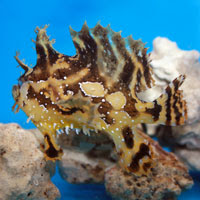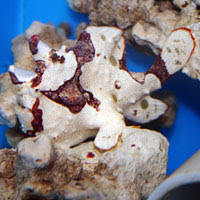Hello, Frank Indiviglio here.
In Part I of this article we examined some important points concerning freshwater stingray ownership. I’ll continue here with more husbandry tips and a look at the natural history of two unique species.
Selecting an Individual: Health
 Large rays may have been collected via hook, do not ship well, and usually arrive in very poor condition. Check those over 12 inches in diameter carefully. Their adjustment to captivity is much less successful than that of smaller individuals.
Large rays may have been collected via hook, do not ship well, and usually arrive in very poor condition. Check those over 12 inches in diameter carefully. Their adjustment to captivity is much less successful than that of smaller individuals.
Do not purchase a stingray whose fins are curled upwards along their margins. For reason as yet unknown, such animals invariably expire in short order.
Identifying the Various Species
It is important that you lean to identify the commonly available species before making a purchase. Animals in the genus Dasyatis, commonly sold as “freshwater stingrays” are actually native to brackish waters (river mouths) and may fare poorly in freshwater aquariums. Others, including ceja, antenna, tiger and China rays, have unique feeding and water quality requirements, and make quite delicate captives.
The hardy, popular common or motoro ray (Potamotrygon motoro) exists in 6-8 distinct color morphs, and is difficult to identify based on appearance alone.
Diet
Freshwater stingrays have fast metabolisms and need 2-3 feedings each day; dietary variety is vital to good health.
Live blackworms, ghost shrimp, crayfish, earthworms and small fishes are necessary for newly-acquired specimens. Eventually, most can be habituated to accepting canned invertebrates and animal-based frozen foods, but live animals remain an important component of the diet.
Stingray Tankmates
While rays often get along well with each other and certain other fishes, the usually benign suckermouth catfishes (i.e. Plecostomus spp) present an unusual problem. They often latch onto stingrays’ backs, sucking at the skin and causing lesions and stress-related ailments. The reasons for this behavior have not yet been thoroughly investigated.
Legality
You would be well-advised to check the legality of stingray ownership, as 8-10 states currently prohibit the keeping of freshwater species.
A Freshwater Ray in the USA?
Most freshwater rays offered in the trade hail from South America, but others may be found in Asia, Africa and Australia.
 Interestingly, Florida’s St. John’s River is home to a population of marine rays that have adapted to life in fresh water. The species involved, the Atlantic stingray, Dasyatis sabina (please see photo), is known to forage in river mouths, but the St. John’s River population is the only one that has become independent of the sea, even breeding in freshwater.
Interestingly, Florida’s St. John’s River is home to a population of marine rays that have adapted to life in fresh water. The species involved, the Atlantic stingray, Dasyatis sabina (please see photo), is known to forage in river mouths, but the St. John’s River population is the only one that has become independent of the sea, even breeding in freshwater.
An Amazing Giant
Southeast Asia is home to the world’s largest freshwater stingray, Himantura chaophraya. In January of 2009 a researcher captured a massive specimen in Thailand’s Meaklong River. Spanning nearly 9 feet across and weighing an estimated 660 pounds, the giant appeared pregnant and was released unharmed.
A Hands-On Experience with Stingrays
Please be sure to visit That Fish Place/That Pet Place in Lancaster, PA (the world’s largest pet store) for a chance to hand feed our friendly marine stingrays.
I’ll cover the care of freshwater, marine and even some native stingrays in detail in future articles. Until then, please write in with your questions and comments.
Thanks, Frank Indiviglio
Further Reading
You can learn more about Southeast Asia’s spectacular giant freshwater stingray here.
Please also check out the book, Freshwater Stingrays for more on captive care.
Image referenced from Wikipedia and originally published by the user Abigor.
 That Fish Blog – Aquarium Advice and Information
That Fish Blog – Aquarium Advice and Information



